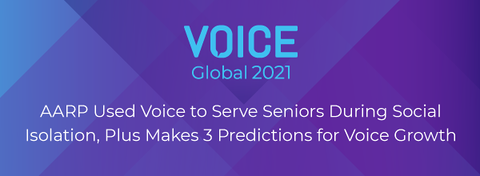AARP Used Voice to Serve Seniors During Social Isolation, Plus Makes 3 Predictions for Voice Growth
VOICE Global 21-08-9 Modev Staff Writers 3 min read

AARP is the world's largest nonprofit and social impact organization. Its goal is to advance the needs of older and more vulnerable adults. It serves a member-driven community of 39 million members, mainly in the United States, but is steadily expanding globally.
Paulo Narciso, vice president of Product and Program Development at the AARP Foundation, joined us at VOICE Global 2021 to share how the Foundation tapped into the power of voice tech to help seniors break out of the isolation brought on by the global pandemic. He also shared where he sees the most significant opportunities for voice tech to grow within the seniors' care market.
Meals on Wheels
One of the Foundation's first initiatives when the pandemic hit was a food assistance program. Isolation mandates coupled with shops closing or reducing their opening hours created a situation for many seniors. Basic things, such as having access to nutritious food, became a challenge.
AARP provides a platform, built entirely on Alexa and Google Assistant, called Connected Communities, which allows seniors to interact vocally with their smart speakers. Through that platform, the Foundation delivered a little over 3.2 million meals to older Americans who were struggling to have food in the pantry between May and July 2020.
"Voice was one of the enabling technologies that allowed us to identify those that needed assistance and allowed us to deliver those meals to the folks that needed it, quickly," says Narciso.
Tech that Sticks
Adoption is another factor in the success AARP has had with voice technology. Narciso tells us that, in his experience, once seniors adopt voice tech, it tends to become a permanent staple in their lives and for many reasons.
The text might be too small for them to read correctly on their phone, and voice frees them from that limitation. Also, seniors prefer to have their hands free to perform other tasks when interacting with technology, which quickly compels many to adopt voice technology.
And yet another reason for the high adoption rates in seniors comes from a caregiving perspective: being able to check in on loved ones. Smart speakers allow for easy and accessible communication with seniors. They don't need to worry about a specific device they need to find and interact with to communicate. Voice tech removes that friction and streamlines communication.
"Once seniors learn how to use a device like Alexa or to use voice on their phones, we find that it becomes their preferred medium of communication and their preferred way to interact with technology," Narciso continues.
Growing Voice into the Future
So how will voice-enabled technologies help seniors moving forward? Narciso identifies three (3) main areas of growth for voice tech within the seniors' care market:
- Breaking social isolation. Social isolation was already an issue for seniors before the pandemic, and the pandemic has exacerbated the problem. The needs are greater than ever in that area, and so, the chances are high that initiatives to break seniors' isolation will be a significant driver for growth in voice tech.
- Caregiving. Contact with loved ones through voice will continue to be important. Through the use of smart speakers, we're able to get in touch with seniors, check in on them, make sure they're taking their medication - even more quickly than through a phone call. And it also allows us to simply engage through telling them stories, and having them share their stories. It can make all the difference in the world.
- Brain health or cognitive health. We've all seen apps and games that are geared towards cognitive health. These tend to be visual, mathematical and logical, puzzles to solve. But now, we see an emerging trend to adapt these apps and puzzles to voice-only interfaces that also help individuals stay sharp. And that trend that will only grow moving forward.
While Narciso believes these avenues for growth are very promising, it is access to information and participation in society that are driving AARP's initiatives in voice tech.
"But again, as a general rule, we see voice as a way to be able to more easily navigate and be able to access information and tools that a senior may not be able to access using traditional screens. An example of that, for instance, is access to benefits. Is there a way for us to have seniors apply for Medicare or Medicaid or food assistance through a voice application versus having them go to a website? So, lots of opportunities in the use of voice," Narciso concludes.
Missed VOICE Global live? Watch Paulo Narciso discuss AARP's innovative use of voice tech to help seniors and voice tech's growth opportunities he sees moving forward within the seniors care market at VOICE Global on-demand here. View the VOICE Global speaker lineup to see what other engaging speakers joined us across various industries.